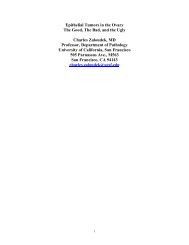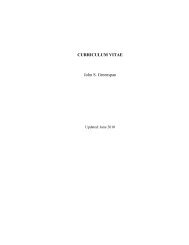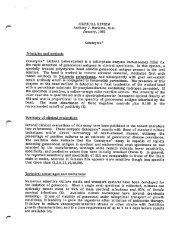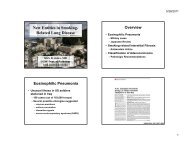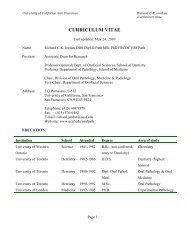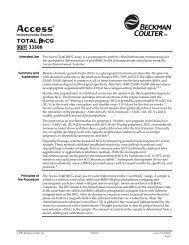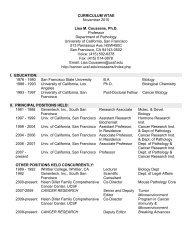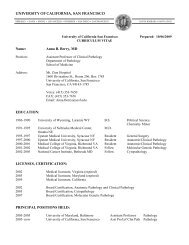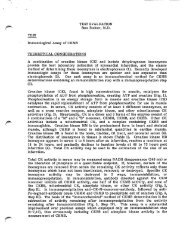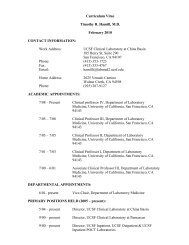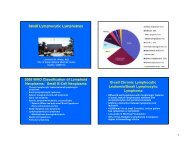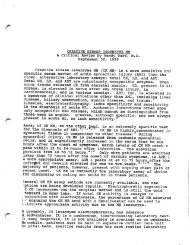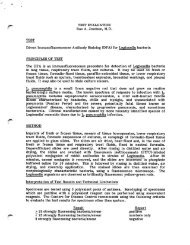25OH Vitamin D Total Assay - University of California, San Francisco
25OH Vitamin D Total Assay - University of California, San Francisco
25OH Vitamin D Total Assay - University of California, San Francisco
Create successful ePaper yourself
Turn your PDF publications into a flip-book with our unique Google optimized e-Paper software.
UNIVERSITY OF CALIFORNIA SAN FRANCISCO, CLINICAL LABORATORIES<br />
Procedure Title: <strong>25OH</strong> <strong>Vitamin</strong> D <strong>Total</strong> <strong>Assay</strong> – DiaSorin LIAISON<br />
Document Section: CHEMISTRY Author: Kirk Sujishi, Linda Post Date Authored: NOVEMBER 2009<br />
Laboratory Director: TED KURTZ, MD (PARNASSUS & CHINA BASIN)<br />
Distribution: China Basin: CHEMISTRY<br />
In Use Date: December 7, 2009 Discontinued Date: ___________<br />
Revised By : ________________________ Reason:______________________________________Date: ____________<br />
Revised By : ________________________ Reason:______________________________________Date: ____________<br />
Revised By : ________________________ Reason:______________________________________Date: ____________<br />
Revised By : ________________________ Reason:______________________________________Date: ____________<br />
Revised By : ________________________ Reason:______________________________________Date: ____________<br />
Annual Director’s Approval (P/CB): ___________________________ Date: ________________<br />
Annual Director’s Approval (P/CB): ___________________________ Date: ________________<br />
Annual Director’s Approval (P/CB): ___________________________ Date_________________<br />
Annual Director’s Approval (P/CB): ___________________________ Date_________________<br />
Annual Director’s Approval (P/CB): ___________________________ Date_________________<br />
Annual Director’s Approval (P/CB): ___________________________ Date: ________________<br />
Annual Director’s Approval (P/CB): ___________________________ Date: ________________<br />
Annual Director’s Approval (P/CB): ___________________________ Date_________________<br />
Annual Director’s Approval (P/CB): ___________________________ Date_________________<br />
eterr:Library:Mail Downloads:<strong>25OH</strong>VitD<strong>Total</strong>.doc Page 1 <strong>of</strong> 15
I. PURPOSE<br />
UNIVERSITY OF CALIFORNIA SAN FRANCISCO, CLINICAL LABORATORIES<br />
The LIAISON 25 OH <strong>Vitamin</strong> D TOTAL <strong>Assay</strong> uses chemiluminescent immunoassay (CLIA)<br />
technology for the quantitative determination <strong>of</strong> 25-hydroxyvitiamin D and other hydroxylated vitamin<br />
D metabolites in human serum to be used in the assessment <strong>of</strong> vitamin D sufficiency. <strong>Assay</strong> results<br />
should be used in conjunction with other clinical or laboratory data to assist the clinician in making<br />
individual patient management decisions in an adult population.<br />
SUMMARY AND EXPLANATION OF TEST<br />
The role <strong>of</strong> vitamin D in bone and mineral metabolism was recognized from its first identification as a<br />
factor that could cure rickets. However, vitamin D is now recognized as a prohormone, which has<br />
multiple roles in maintaining optimal health.<br />
<strong>Vitamin</strong> D3 (cholecalciferol) and vitamin D2 (ergocalciferol) are the most abundant forms <strong>of</strong> vitamin D<br />
in the body. <strong>Vitamin</strong> D is synthesized in the skin from 7-dehydrocholesterol in response to sunlight.<br />
The best nutritional sources <strong>of</strong> D3 are oily fish, primarily salmon and mackerel. <strong>Vitamin</strong> D2‘s nutritional<br />
sources are some vegetables, yeast and fungi. The vegetarian diet is abundant in vitamin D2.<br />
<strong>Vitamin</strong> D (D3, D2 and metabolites) is converted to 25-hydroxyvitamin D in the liver. The<br />
measurement <strong>of</strong> 25-OH vitamin D concentration in the serum or plasma is the best indicator <strong>of</strong><br />
vitamin D nutritional status.<br />
The optimal level <strong>of</strong> 25-OH vitamin D is subject to some debate, but >32ng/mL (>80nmol/L) is<br />
accepted as sufficient for bone health. <strong>Vitamin</strong> D toxicity is a recognized problem, but a rare<br />
occurrence. Instead, a recent growing public health problem is vitamin D insufficiency. Several<br />
research studies have identified widespread vitamin D insufficiency in apparent healthy populations<br />
world-wide.<br />
<strong>Vitamin</strong> D deficiency is commonly treated with vitamin D2 or D3 medications in doses ranging from<br />
50,000 IU/month to 50,000 IU/week. Fortified foods and nutrition supplements may contain either<br />
form. To ensure accurate assessment <strong>of</strong> the total vitamin D all forms, including D3, D2 and<br />
metabolites, must be measured.<br />
Recent studies have identified an inactive 3-epimer <strong>of</strong> 25-OH vitamin D, which may be present in the<br />
serum <strong>of</strong> infants under the age <strong>of</strong> one year. Thus it is important that an assay avoid measuring the<br />
inactive 3-epi form and only measure the active D3 and D2 forms equally.<br />
BIOLOGICAL PRINCIPLES OF THE PROCEDURE<br />
The LIAISON 25 OH <strong>Vitamin</strong> D assay is a direct competitive chemiluminescence immunoassay<br />
(CLIA) for quantitative determination <strong>of</strong> total 25 OH vitamin D in serum. During the first incubation, 25<br />
OH vitamin D is dissociated from its binding protein and binds to the specific antibody on the solid<br />
phase. After 10 minutes, the tracer (vitamin D linked to an isoluminol derivative) is added. After a<br />
second 10 minute incubation, the unbound material is removed with a wash cycle. Subsequently, the<br />
starter reagents are added to initiate a flash chemiluminescent reaction. The light signal is measured<br />
by a photomultiplier as relative light units (RLU) and is inversely proportional to the concentration <strong>of</strong><br />
25 OH vitamin D present in calibrators, controls or samples.<br />
II. POLICY/SCOPE<br />
This procedure is intended for use by licensed CLS staff in the China Basin Chemistry section.<br />
III. TEST AVAILABILITY<br />
Test performed Monday, Wednesday and Fridays. Results will be available by 16:00.<br />
eterr:Library:Mail Downloads:<strong>25OH</strong>VitD<strong>Total</strong>.doc Page 2 <strong>of</strong> 15
IV. SPECIMEN REQUIRMENTS<br />
SPECIMEN TYPES<br />
UNIVERSITY OF CALIFORNIA SAN FRANCISCO, CLINICAL LABORATORIES<br />
1. Human serum or SST tubes.<br />
2. Fasting samples are recommended, but not required.<br />
3. Grossly hemolyzed or lipemic samples as well as samples containing particulate matter or<br />
exhibiting obvious microbial contamination should not be tested.<br />
4. The Diasorin LIAISON does not provide the capability to verify specimen type. It is the<br />
responsibility <strong>of</strong> the operator to verify that the correct specimen type is used in the <strong>25OH</strong> <strong>Vitamin</strong><br />
D TOTAL assay.<br />
PREPARATION FOR ANALYSIS<br />
STORAGE<br />
STABILITY<br />
1. The minimum volume required is 250 µL <strong>of</strong> specimen for the first test, and 25 µL more for each<br />
additional test.<br />
2. Mix thawed specimens thoroughly by low speed vortexing or by inverting 10 times. Visually<br />
inspect the specimens. If layering or stratification is observed, continue mixing until specimens<br />
are visibly homogeneous.<br />
3. Samples having particulate matter, turbidity, lipemia or erythrocyte debris may require clarification<br />
by filtration or centrifugation before testing. Check for and remove air bubbles before assaying.<br />
1. Frozen (-20˚C or below). Mix thawed samples well before testing.<br />
2. Specimens may be stored in glass or plastic vials. No additives or preservatives are required to<br />
maintain integrity <strong>of</strong> the samples.<br />
3. Avoid multiple freeze/thaw cycles. Samples should not be tested if exposed to more than three<br />
freeze/thaw cycles.<br />
After separation from cells:<br />
• Ambient: 3 days<br />
• Refrigerated: 1 week<br />
• Frozen: 6 months<br />
V. EQUIPMENT, REAGENTS AND SUPPLIES<br />
TEST INSTRUMENT: DiaSorin LIAISON System<br />
MATERIALS PROVIDED<br />
DiaSorin LIAISON Reagent Integral (Cat. No. 310600)<br />
MATERIALS REQUIRED BUT NOT PROVIDED<br />
1. DiaSorin LIAISON System (including sample racks).<br />
eterr:Library:Mail Downloads:<strong>25OH</strong>VitD<strong>Total</strong>.doc Page 3 <strong>of</strong> 15
REAGENTS<br />
UNIVERSITY OF CALIFORNIA SAN FRANCISCO, CLINICAL LABORATORIES<br />
2. LIAISON Module (Cat. No. 319130)<br />
3. LIAISON Starter Kit (Cat. No. 319102)<br />
4. LIAISON Light Check (Cat. No. 319101)<br />
5. LIAISON Wash/System Fluid (Cat No. 319100)<br />
6. LIAISON Waste Bags (Cat. No. 9450003)<br />
7. LIAISON 25 OH <strong>Vitamin</strong> D TOTAL Control Set (Cat. No. 310601)<br />
8. LIAISON 25 OH <strong>Vitamin</strong> D TOTAL Specimen Diluent (Cat. No. 310602)<br />
9. LIAISON 25 OH <strong>Vitamin</strong> D TOTAL Calibration Verifiers (Cat. No. 310603)<br />
10. LIAISON Cleaning Kit (Cat. No. 310990)<br />
11. LIAISON Xcelerator (Cat. No. A0090)<br />
12. Centrifuge (IEC Centra-7, International Equipment Company)<br />
13. 12 x 75 glass or plastic tubes<br />
14. Transfer pipettes<br />
15. Calibrated pipettes for delivering volumes <strong>of</strong> 75 µL and 225 µL<br />
16. For information on materials required for maintenance procedures, refer to the DiaSorin Liaison<br />
User Manual, Chapter 18.<br />
DIASORIN LIAISON REAGENT INTEGRAL, 100 TESTS, the following components are all contained<br />
within the Reagent Integral:<br />
1. Magnetic Particles (2.4 mL) Magnetic particles coated with antibody against 25 OH <strong>Vitamin</strong> D,<br />
protein, phosphate buffer, < 0.1% sodium azide.<br />
2. <strong>Assay</strong> Buffer (28.0 mL) Buffer with 10% ethanol, surfactants and preservatives.<br />
3. Conjugate (4.5 mL) 25 OH <strong>Vitamin</strong> D conjugated to an isoluminol derivative, in phosphate buffer<br />
with 10% ethanol, EDTA, surfactant and preservatives.<br />
4. Calibrator 1 (1.0 mL) Human serum, Tris Buffer, < 0.1% sodium azide and 25 OH <strong>Vitamin</strong> D.<br />
The calibrator concentrations (ng/mL) are referenced to standard preparations containing highly<br />
purified 25 OH <strong>Vitamin</strong> D.<br />
5. Calibrator 2 (1.0 mL) Human serum, Tris Buffer, < 0.1% sodium azide and 25 OH <strong>Vitamin</strong> D.<br />
The calibrator concentrations (ng/mL) are referenced to standard preparations containing highly<br />
purified 25 OH <strong>Vitamin</strong> D.<br />
OTHER REAGENTS<br />
1. LIAISON STARTERS<br />
eterr:Library:Mail Downloads:<strong>25OH</strong>VitD<strong>Total</strong>.doc Page 4 <strong>of</strong> 15
UNIVERSITY OF CALIFORNIA SAN FRANCISCO, CLINICAL LABORATORIES<br />
a. LIAISON STARTER 1: Catalyst in 4% NaOH<br />
b. LIAISON STARTER 2: 0.12% peroxide solution<br />
2. LIAISON WASH/SYSTEM LIQUID: Phosphate buffer solution (10x concentrate). Preservative:<br />
sodium azide.<br />
3. LIAISON LIGHT CHECK<br />
4. LIAISON 25 OH VITAMIN D TOTAL CONTROL SET (with Bar Code Labels for Controls 1 and 2)<br />
a. CONTROL LEVEL 1: Human serum with buffer salts and < 0.1% sodium azide as a<br />
preservative.<br />
b. CONTROL LEVEL 2: Human serum with buffer salts and < 0.1% sodium azide as a<br />
preservative.<br />
5. LIAISON 25 OH VITAMIN D TOTAL SPECIMEN DILUENT: Human serum with buffer salts and<br />
UNIVERSITY OF CALIFORNIA SAN FRANCISCO, CLINICAL LABORATORIES<br />
6. LIAISON 25 OH VITAMIN D TOTAL SPECIMEN DILUENT is stored at 2 – 8˚C upon receipt.<br />
When stored and handled as directed, the reagent is stable until the expiration date.<br />
7. LIAISON 25 OH VITAMIN D TOTAL CALIBRATION VERIFIERS are stored at 2 – 8˚C upon<br />
receipt. When stored and handled as directed, the reagent is stable until the expiration date.<br />
Once the vials are opened, the reagents are stable for 4 weeks when properly stored.<br />
INDICATIONS OF REAGENT DETERIORATION<br />
When a control value is out <strong>of</strong> the specified range, it may indicate deterioration <strong>of</strong> the reagents or<br />
errors in technique. Associated test results are invalid and samples must be retested. <strong>Assay</strong><br />
recalibration may be necessary.<br />
VI. WARNINGS AND PRECAUTIONS<br />
CAUTION<br />
For In Vitro Diagnostic Use.<br />
1. This product requires the handling <strong>of</strong> human specimens. It is recommended that all human<br />
sourced materials be considered potentially infectious and be handled in accordance with the<br />
OSHA Standard on Bloodborne Pathogens. Biosafety Level 2 or other appropriate biosafety<br />
practices should be used for materials.<br />
2. Some reagents used in this assay contain human source material and should be treated as<br />
potentially infectious. Each unit used in the preparation <strong>of</strong> this product has been tested by an<br />
FDA-approved method and found non-reactive for the presence <strong>of</strong> HBsAg, antibody to HCV and<br />
antibody to HIV1/2. While these methods are highly accurate, they do not guarantee that all<br />
infected units will be detected. This product may also contain other human source material for<br />
which there is no approved test. Because no known test method can <strong>of</strong>fer complete assurance<br />
that hepatitis B virus, hepatitis C virus (HCV), Human Immunodeficiency Virus (HIV) or other<br />
infectious agents are absent, all products containing human source material should be handled in<br />
accordance with good laboratory practices using appropriate precautions as described in the<br />
Centers for Disease Control and Prevention / National Institutes <strong>of</strong> Health Manual, “Biosafety in<br />
Microbiological and Biomedical Laboratories.” 4th ed., May 1999.<br />
3. Some reagents contain sodium azide as a preservative. Because sodium azide may form<br />
explosive lead azide or copper azide in plumbing, it is recommended that drains be thoroughly<br />
flushed with water after disposal <strong>of</strong> solutions containing sodium azide.<br />
4. For a detailed discussion <strong>of</strong> safety precautions during system operation, refer to the LIAISON<br />
User Manual.<br />
HANDLING PRECAUTIONS<br />
Do not use reagent kits beyond the expiration date.<br />
1. Contents <strong>of</strong> starter reagent bottles should never be pooled when replacing new containers with<br />
those in use, regardless <strong>of</strong> lot number.<br />
2. Before placing an integral on the instrument, suspend the magnetic particles in the first<br />
compartment by placing the integral in the Xcelerator for 30 seconds, then rotate the<br />
compartment for an additional minute. Check that all particles have been resuspended. Place<br />
the integral into the reagent bay and allow the instrument mixing to proceed for at least 30<br />
minutes prior to starting a test run.<br />
eterr:Library:Mail Downloads:<strong>25OH</strong>VitD<strong>Total</strong>.doc Page 6 <strong>of</strong> 15
UNIVERSITY OF CALIFORNIA SAN FRANCISCO, CLINICAL LABORATORIES<br />
3. Before loading an integral onto the instrument, check reagent compartments for bubbles and<br />
liquid adherence to the covers; remove if present.<br />
4. Newly prepared Wash/System Liquid must sit for 6 hours to de-gas prior to use on the instrument.<br />
5. Wash/System Liquid tanks must be bleached monthly according to manufacturer’s<br />
recommendations and rinsed thoroughly to prevent build up <strong>of</strong> residue from Wash/System Liquid,<br />
which could affect background readings. See maintenance procedures.<br />
VII. CALIBRATION / CALIBRATION VERIFICATION<br />
1. The predefined Master Curve is adjusted to a new instrument-specific curve using the two<br />
calibrators supplied in the Reagent Integral via the bar codes on the reagent integral label.<br />
2. Renewed calibration is required:<br />
a. With each new lot <strong>of</strong> reagents (Reagent Intergral or Starter Reagents).<br />
b. Every 7 days.<br />
c. After each servicing <strong>of</strong> the LIAISON Analyzer.<br />
d. If quality controls are out <strong>of</strong> acceptable range.<br />
3. Refer to the LIAISON Daily Quick Start Procedure for detailed information on how to perform an<br />
assay calibration.<br />
4. Refer to Appedix II for detailed information on how to perform a Calibration Verification.<br />
VIII. QUALITY CONTROL<br />
LIAISON 25 OH VITAMIN D TOTAL CONTROL SET (with Bar Code Labels for Controls 1 and 2)<br />
1. Controls are received in liquid form and require no further dilution prior to use.<br />
2. The controls are stored at 2 – 8˚C upon receipt. When stored and handled as directed, the<br />
reagent is stable until the expiration date.<br />
3. LIAISON 25 OH VITAMIN D TOTAL controls levels 1 and 2 are run each day <strong>of</strong> testing.<br />
IX. PROCEDURE<br />
ASSAY PROCEDURE<br />
For detailed instructions on the following steps, refer to LIAISON Daily Quick Start Procedure.<br />
For additional information on principles <strong>of</strong> operation, refer to the LIAISON User Manual.<br />
1. Prepare the Analyzer.<br />
a. Prepare Reagent Intergals.<br />
b. Check Instrument Status.<br />
c. Check Status <strong>of</strong> Data from Prior Run.<br />
d. Check Printer Status.<br />
2. Perform System Test.<br />
3. Perform Calibration if required.<br />
4. Run LIAISON 25 OH VITAMIN D TOTAL controls levels 1 and 2.<br />
5. Program, place and run patient samples.<br />
eterr:Library:Mail Downloads:<strong>25OH</strong>VitD<strong>Total</strong>.doc Page 7 <strong>of</strong> 15
UNIVERSITY OF CALIFORNIA SAN FRANCISCO, CLINICAL LABORATORIES<br />
6. Validate and print control and patient results.<br />
7. Save the database to the designated flash drive.<br />
8. Perform Daily Shut-Down procedure.<br />
9. For optimal performance, it is important to perform routine maintenance as described in the<br />
LIAISON User Manual. Detailed instructions may be found in the DisSorin LIAISON Maintenance<br />
procedure.<br />
SPECIMEN DILUTION PROCEDURES<br />
Specimens with a 25 OH <strong>Vitamin</strong> D <strong>Total</strong> result <strong>of</strong> >150 ng/mL will be flagged as “>>”. Samples<br />
should be diluted with LIAISON 25 OH <strong>Vitamin</strong> D TOTAL Specimen Diluent. Note that all lots <strong>of</strong><br />
specimen diluent are interchangeable between LIAISON 25 OH <strong>Vitamin</strong> D TOTAL <strong>Assay</strong> kit lots.<br />
Manual dilutions should be done as follows:<br />
a. A dilution <strong>of</strong> one part patient to 3 parts diluent is recommended, resulting in a 1:4 dilution.<br />
b. Mix specimen diluent thoroughly by gentle inversion prior to use.<br />
c. Add 75 µL <strong>of</strong> patient sample to 225 µL <strong>of</strong> specimen diluent.<br />
d. Mix well or vortex gently.<br />
X. RESULTING/REPORTABLE RANGE<br />
The predefined Master Curve is adjusted to a new instrument-specific curve using the two calibrators<br />
supplied in the reagent integral via the bar codes on the reagent integral label.<br />
Some results may contain information in the flags column <strong>of</strong> the report. For a description <strong>of</strong> the flags<br />
that may appear refer to the posted reference table or to the LIAISON Quick Guide Appendix, page<br />
25.<br />
ANALYTICAL MEASUREMENT RANGE & REPORTABLE RANGE<br />
The analytical measurement range for the DiaSorin LIAISON 25 OH <strong>Vitamin</strong> D <strong>Total</strong> <strong>Assay</strong> is 4<br />
ng/mL to 150 ng/mL.<br />
The lowest reportable value is 4 ng/mL, based on an inter-assay precision that approximates 20% CV<br />
(functional sensitivity). Values below 4 ng/mL should be reported as
XII LIMITATIONS OF PROCEDURE<br />
UNIVERSITY OF CALIFORNIA SAN FRANCISCO, CLINICAL LABORATORIES<br />
1. <strong>Assay</strong> results should be utilized in conjunction with other clinical and laboratory data to assist the<br />
clinician in making individual patient management decisions in an adult population.<br />
2. The antibody utilized in this assay will demonstrate cross reactivity to many dihydroxylated<br />
metabolites <strong>of</strong> vitamin D. However, in humans, these compounds are naturally present in<br />
picomolar concentrations.<br />
3. Bacterial contamination or repeated freeze-thaw cycles (>3) may affect the test results.<br />
4. A skillful technique and strict adherence to the instructions are necessary to obtain reliable<br />
results.<br />
5. The concentration <strong>of</strong> vitamin D in a given specimen determined with assays from different<br />
manufacturers may vary due to differences in methods and reagent specificity.<br />
XIII SPECIFICITY/INTERFERENCES<br />
SPECIFICITY<br />
Data on the cross-reactivity <strong>of</strong> the antiserum used in this assay were obtained by spiking up to 100<br />
ng/mL <strong>of</strong> the potential cross-reactant and assaying. The cross-reactivity <strong>of</strong> each compound,<br />
normalized to 25 OH <strong>Vitamin</strong> D3 is listed below.<br />
INTERFERENCE<br />
Steroid % Cross-reactivity<br />
25 OH <strong>Vitamin</strong> D2 104%<br />
25 OH <strong>Vitamin</strong> D3 100%<br />
<strong>Vitamin</strong> D2
Plasma<br />
METHOD COMPARISON<br />
TRUENESS<br />
UNIVERSITY OF CALIFORNIA SAN FRANCISCO, CLINICAL LABORATORIES<br />
Repeatability P1 P2 P3 P4<br />
Number <strong>of</strong> determinations 80 80 80 80<br />
Mean (ng/mL) 5.91 45.9 52.6 62.7<br />
Standard Deviation (ng/mL) 0.48 1.51 1.71 3.25<br />
Coefficient <strong>of</strong> Variation (%) 8.1 3.3 3.2 5.2<br />
Reproducibility P1 P2 P3 P4<br />
Number <strong>of</strong> determinations 80 80 80 80<br />
Mean (ng/mL) 5.91 45.9 52.6 62.7<br />
Standard Deviation (ng/mL) 0.75 3.19 3.65 4.92<br />
Coefficient <strong>of</strong> Variation (%) 12.7 6.9 6.9 7.9<br />
A total <strong>of</strong> 155 samples was tested by LIAISON 25 OH <strong>Vitamin</strong> D TOTAL and by DiaSorin 25 OH<br />
<strong>Vitamin</strong> D RIA. The resulting regression equation was:<br />
LIAISON = 0.99 (RIA) + 2.4; R = 0.97.<br />
The assay trueness has been verified by the dilution and recovery tests.<br />
1. Dilution Test:<br />
Five samples were diluted with LIAISON 25 OH <strong>Vitamin</strong> D TOTAL Specimen Diluent and<br />
analyzed. The results were analyzed as a linear regression <strong>of</strong> the Expected vs. Observed values.<br />
The resulting regression equation is: Observed = Expected 0.99 + 0.1; R = 0.99.<br />
2. Recovery Test<br />
High concentration samples were mixed with low concentration samples in ratios <strong>of</strong> 1:2, 1:1, and<br />
2:1. The observed values were then compared to the expected values to determine the %<br />
recovery. The mean recovery is 102%.<br />
Sample 1<br />
High neat<br />
2 H : 1 L<br />
1 H : 1 L<br />
1 H : 2 L<br />
Low neat<br />
Expected Concentration<br />
(ng/mL)<br />
35.1<br />
30.6<br />
26.0<br />
Observed Concentration<br />
(ng/mL)<br />
44.0<br />
34.1<br />
32.1<br />
25.7<br />
17.2<br />
% Recovery<br />
97%<br />
105%<br />
99%<br />
eterr:Library:Mail Downloads:<strong>25OH</strong>VitD<strong>Total</strong>.doc Page 10 <strong>of</strong> 15
Sample 2<br />
High neat<br />
2 H : 1 L<br />
1 H : 1 L<br />
1 H : 2 L<br />
Low neat<br />
Sample 3<br />
High neat<br />
2 H : 1 L<br />
1 H : 1 L<br />
1 H : 2 L<br />
Low neat<br />
Sample 4<br />
High neat<br />
2 H : 1 L<br />
1 H : 1 L<br />
1 H : 2 L<br />
Low neat<br />
Sample 5<br />
High neat<br />
2 H : 1 L<br />
1 H : 1 L<br />
1 H : 2 L<br />
Low neat<br />
UNIVERSITY OF CALIFORNIA SAN FRANCISCO, CLINICAL LABORATORIES<br />
74.9<br />
59.4<br />
43.9<br />
59.9<br />
48.9<br />
37.8<br />
93.2<br />
73.7<br />
54.2<br />
84.8<br />
64.8<br />
44.8<br />
XV ALTERNATE METHODS<br />
105.0<br />
76.0<br />
58.2<br />
45.6<br />
13.8<br />
81.4<br />
60.4<br />
48.2<br />
36.5<br />
16.3<br />
131.0<br />
92.7<br />
70.4<br />
53.9<br />
16.4<br />
123.6<br />
94.5<br />
68.9<br />
53.0<br />
6.0<br />
101%<br />
98%<br />
104%<br />
101%<br />
99%<br />
97%<br />
99%<br />
96%<br />
99%<br />
111%<br />
106%<br />
118%<br />
Mean Recovery 102%<br />
No backup method is available in the laboratory. Hold samples until instrument is back up. If delay is<br />
expected to be significant, consult with Supervisor or Director.<br />
XVI REFERENCES<br />
DiaSorin LIAISON 25 OH <strong>Vitamin</strong> D TOTAL <strong>Assay</strong> package insert<br />
DiaSorin LIAISON Starter package insert<br />
DiaSorin LIAISON Light Check package insert<br />
DiaSorin LIAISON Wash/System Liquid package insert<br />
DiaSorin LIAISON 25 OH <strong>Vitamin</strong> D TOTAL Control Set package insert<br />
DiaSorin LIAISON 25 OH <strong>Vitamin</strong> D TOTAL Specimen Diluent Set package insert<br />
DiaSorin LIAISON 25 OH <strong>Vitamin</strong> D TOTAL Calibration Verifiers package insert<br />
DiaSorin LIAISON Cleaning Kit package insert<br />
Holick MF, <strong>Vitamin</strong> D Status: Measurement, Interpretation, and Clinical Application, Annals <strong>of</strong><br />
Epidemiology, 2009 Feb; 19(2):73-8.<br />
Bisch<strong>of</strong>f-Ferrari HA et al., Estimation <strong>of</strong> optimal serum concentrations <strong>of</strong> 25-hydroxyvitamin D for<br />
multiple health outcomes, American Journal <strong>of</strong> Clinical Nutrition, 2006; 84:18-28.<br />
eterr:Library:Mail Downloads:<strong>25OH</strong>VitD<strong>Total</strong>.doc Page 11 <strong>of</strong> 15



